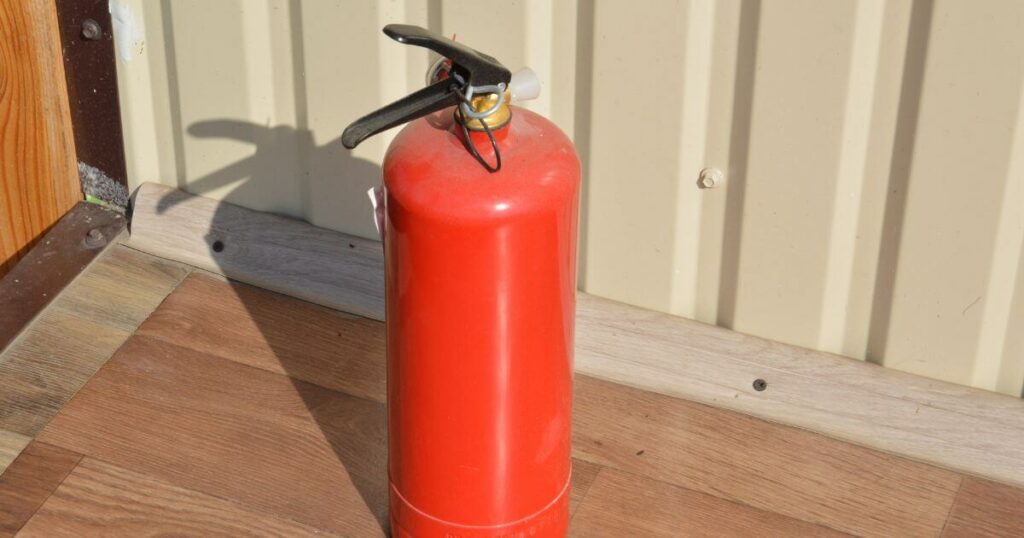Creating an Effective Home Fire Escape Plan: Beyond Alarms
Imagine waking up to the sound of crackling flames and thick smoke filling your home. Would you know exactly what to do? A well-prepared home fire safety plan can mean the difference between life and death in those crucial moments. While alarm systems are an essential first line of defense, true fire safety goes far beyond these devices. At All American Fire Protection, we believe in taking a comprehensive approach to fire safety that ensures every member of your family is protected and prepared. Let’s explore how you can create a comprehensive fire safety plan that protects your family and gives you peace of mind.
The Sobering Reality of House Fires
Before we dive into the details of creating your fire safety plan, it’s important to understand the gravity of the situation. Home fires are more common and devastating than many people realize:
- According to the National Fire Protection Association, a home fire occurs every 93 seconds in the United States.
- On average, seven people die in home fires each day.
- Cooking equipment is the leading cause of home fires and fire injuries.
These statistics aren’t meant to scare you but to emphasize why a comprehensive fire safety plan is so crucial. Relying solely on smoke alarms isn’t enough – you need a multi-faceted approach to truly protect your home and loved ones.
Components of a Comprehensive Fire Safety Plan
1. Early Detection: More Than Just Smoke Alarms
While smoke detectors are vital, they’re just the beginning of an effective early warning system. Here’s how to enhance your home’s fire detection capabilities:
- Types of fire detection devices:
- Smoke alarms (both ionization and photoelectric)
- Heat detectors
- Carbon monoxide detectors
- Multi-sensor detectors
- Proper placement and maintenance:
- Install detectors on every level of your home, including the basement
- Place detectors inside and outside sleeping areas
- Test all devices monthly
- Replace batteries at least once a year (or when the low-battery alarm sounds)
- Replace the entire unit every 10 years
- Smart home integration:
- Consider interconnected alarms that trigger all units when one detects smoke
- Explore smart detectors that can send alerts to your phone
- Integrate with home automation systems for additional safety features
By expanding your detection system beyond basic smoke alarms, you’re giving yourself valuable extra seconds to react in case of a fire.

2. Mapping Your Escape Routes
Knowing how to get out quickly is crucial when every second counts. Here’s how to create an effective home fire escape plan:
- Draw a floor plan of your home, marking all possible exits from each room.
- Identify two ways out of every room, typically a door and a window.
- Ensure all doors and windows can be opened easily.
- If you have a multi-story home:
- Consider installing escape ladders for the upper floors
- Practice using them from first-floor windows first
- Teach children how to escape on their own in case you can’t reach them.
- Plan for family members with mobility issues or disabilities.
- Don’t forget about your pets – assign someone to help them escape.
| Room Type | Primary Exit | Secondary Exit | Special Considerations |
|---|---|---|---|
| Bedroom | Door | Window | Escape ladder for upper floors |
| Living Room | Front Door | Window | A clear path to exits |
| Kitchen | Door to Outside | Door to Another Room | Fire extinguisher location |
| Basement | Stairs Up | Egress Window | Window well ladder |
Remember, in a real fire, your primary route might be blocked. That’s why having and practicing alternative escape routes is so important.
3. Designating a Safe Meeting Point
Once everyone is out of the house, you need a predetermined meeting place and make sure everyone is accounted for. Here’s how to choose and use a safe meeting point:
- Select a location that is:
- A safe distance from your home (across the street or at a neighbor’s house)
- Easy for everyone to remember
- Accessible in any weather
- Known to all family members and regular visitors
- Teach everyone to go directly to the meeting point after escaping.
- Practice going to the meeting point during your fire drills.
- Designate one person to call 911 once at the meeting point.
- Never go back inside a burning building – inform firefighters if someone is missing.
Your safe meeting point is where you’ll regroup, count heads, and wait for emergency services. It’s a crucial part of your evacuation plan that ensures no one is left behind.
4. Fire Extinguisher Placement and Usage
While escape is the primary goal, knowing how to use a fire extinguisher can help you deal with small fires before they become unmanageable. Here’s what you need to know:
- Types of fire extinguishers:
- Class A: For ordinary combustibles like wood and paper
- Class B: For flammable liquids
- Class C: For electrical fires
- Class K: For kitchen fires involving oils and fats
- Strategic placement:
- Keep at least one extinguisher on each floor
- Place them near exits for easy grab-and-go
- Prioritize high-risk areas like the kitchen and garage
- Basic usage: Remember the PASS technique:
- Pull the pin
- Aim at the base of the fire
- Squeeze the handle
- Sweep from side to side
- Training: Ensure all capable family members know how to use an extinguisher.
Remember, fire extinguishers are for small, contained fires only. If you’re in doubt, it’s always better to evacuate and call the fire department.

5. Regular Fire Drills: Practice Makes Perfect
Creating a plan is just the first step – you need to plan and practice it regularly to make it effective. Here’s how to conduct fire drills that prepare your family for a real emergency:
- Frequency: Conduct drills at least twice a year
- Timing: Run drills at different times of day and night
- Realism: Use your smoke alarms during the drill
- Scenarios: Practice different escape routes and situations
During your drills:
- Sound the alarm
- Time how long it takes everyone to reach the meeting point
- Practice crawling low to avoid smoke
- Teach everyone to feel doors for heat before opening
- Practice closing doors behind you to slow fire spread
After each drill, discuss what went well and what needs improvement. This constant refinement will help your family stay prepared.
6. Special Considerations for High-Risk Areas
Some areas of your home are more prone to fires than others. Let’s look at how to address these high-risk zones:
Kitchen Fire Safety:
- Never leave cooking food unattended
- Keep flammable items away from the stove
- Have a lid nearby to smother small grease fires
- Install a Class K fire extinguisher
Bedroom Fire Safety:
- Keep space heaters at least 3 feet from anything flammable
- Don’t smoke in bed
- Use flameless candles or keep lit candles away from curtains and bedding
- Have escape ladders for upper-floor bedrooms
Garage and Workshop Considerations:
- Store flammable liquids in approved containers
- Keep oily rags in a closed metal container
- Don’t store propane tanks indoors
- Have a fire extinguisher readily available
By paying extra attention to these areas, you can significantly reduce your risk of a home fire.

7. Emergency Communication Plan
In the chaos of a fire, clear communication can save lives. Here’s how to ensure everyone knows what to do:
- Create a phone tree with emergency contacts
- Designate an out-of-area contact as a check-in point
- Teach children how to call 911 and give your address
- Consider a family group chat for quick communication
- Practice your communication plan during fire drills
Remember, in a real emergency, texts may be more reliable than phone calls if networks are overwhelmed.
Maintaining and Updating Your Fire Safety Plan
Your fire safety plan isn’t a “set it and forget it” document. It needs regular attention to stay effective:
- Review and update your plan annually
- Check for new technologies that could enhance your safety
- Adjust your plan as your family changes (new members, mobility changes, etc.)
- Consider seasonal risks (e.g., holiday decorations, winter heating)
Keep your plan visible and accessible to all family members. A well-maintained plan ensures you’re always prepared for the unexpected.
Beyond the Basics: Advanced Fire Safety Measures
For those looking to take their fire safety to the next level, consider these advanced measures:
Fire-Resistant Materials and Construction:
- When renovating, choose fire-resistant building materials
- Install fire-rated doors between living spaces and garages
- Consider fire-resistant roofing materials
Home Sprinkler Systems:
- While common in commercial buildings, residential sprinkler systems are becoming more popular
- They can significantly reduce fire damage and increase survival rates
- Consult with a fire protection professional about installation options
Smart Home Integration for Fire Prevention:
- Explore smart stoves that shut off automatically if left unattended
- Install smart outlets that can cut power to appliances remotely
- Set up smart smoke detectors that can alert your phone and automatically shut off HVAC systems to prevent smoke spread
These advanced measures can provide an extra layer of protection for your home and family.
Empowering Your Community
Fire safety doesn’t stop at your front door. By sharing your knowledge and participating in community initiatives, you can help create a safer neighborhood for everyone:
- Share your fire safety plan with neighbors
- Participate in local fire safety events or workshops
- Volunteer with organizations that promote fire safety education
- Advocate for fire safety measures in your community
Remember, a community-wide approach to fire safety benefits everyone. Your actions could inspire others to take fire safety seriously, creating a ripple effect of preparedness.
Your Next Steps: Taking Action Today
Creating an effective home fire safety plan might seem overwhelming, but it’s a critical step in protecting your family. Let’s recap the key points:
- Expand your early detection system beyond basic smoke alarms
- Map out and practice multiple escape routes
- Designate and use a safe meeting point
- Learn proper fire extinguisher use and placement
- Conduct regular, realistic fire drills
- Address high-risk areas in your home
- Establish a clear emergency communication plan
- Regularly maintain and update your safety measures
The time to act is now. Don’t wait for a close call to realize the importance of fire safety. Start by taking these steps:
- Walk through your home and identify potential fire hazards
- Check your existing smoke alarms and replace any that are over 10 years old
- Draw a basic floor plan and mark your escape routes
- Set a date for your first family fire drill
Remember, professional help is available. At All American Fire Protection, we’re committed to helping you create the safest possible environment for your family. Our experts can provide a comprehensive fire safety survey of your home, offering personalized recommendations to enhance your fire safety plan.
Don’t leave your family’s safety to chance. Contact All American Fire Protection today to schedule your free fire safety survey. Together, we can create a plan that gives you peace of mind and ensures your family is prepared for any situation. Your safety is our priority – let’s make it yours too.
from All American Fire Prevention https://allamericanfireusa.com/home-fire-escape-plan-beyond-alarms/
via All American Fire Protection
Comments
Post a Comment